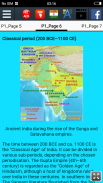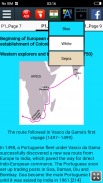









History of India in local languages

History of India in local languages ၏ ရွင္းလင္းခ်က္
Anatomically modern humans are thought to have arrived on the Indian subcontinent between 73,000 and 55,000 years ago.[1] Settled life, which involves the transition from foraging to farming and pastoralism, began in South Asia around 7,000 BCE; during this period, domestication of wheat and barley, rapidly followed by that of goats, sheep, and cattle occurred.[2] By 4,500 BCE, settled life had become more widely prevalent,[2] and eventually evolved into the Indus Valley Civilization. Considered a cradle of civilisation,[3] the Indus Valley civilisation, which spread and flourished in the north-western part of the Indian subcontinent from 3300 to 1300 BCE, was the first major civilisation in South Asia.[4] A sophisticated and technologically advanced urban culture developed in the Mature Harappan period, from 2600 to 1900 BCE.[5] Indus Valley Civilisation was noted for developing new techniques in handicraft, carnelian products, seal carving, metallurgy, urban planning, baked brick houses, efficient drainage systems, water supply systems and clusters of large non-residential buildings.[6] This civilisation collapsed at the start of the second millennium BCE and was later followed by the Iron Age Vedic Period.
In early second millennium BCE persistent drought caused the population of the Indus Valley to scatter from large urban centres to villages. Around the same time, Indo-Aryan tribes moved into the Punjab from regions further northwest in several waves of migration. The resulting Vedic period was marked by the composition of the Vedas, large collections of hymns of these tribes whose postulated religious culture, through synthesis with the preexisting religious cultures of the subcontinent, gave rise to Hinduism. The caste system, which created a hierarchy of priests, warriors, and free peasants arose later during this period. Towards the end of the period, around 600 BCE, after the pastoral and nomadic Indo-Aryans spread from the Punjab into the Gangetic plain, large swaths of which they deforested to pave way for agriculture, a second urbanisation took place. The numerous Indo-Aryan realms, or janapadas, were consolidated into larger states, or mahajanapadas. This urbanisation was accompanied by the rise of new ascetic movements, including Jainism and Buddhism, which challenged the primacy of rituals, presided by Brahmin priests, that had come to be associated with Vedic religion,[7] and gave rise to new religious concepts.[8]
Most of the Indian subcontinent was conquered by the Maurya Empire during the 4th and 3rd centuries BCE. From the 3rd century BCE onwards Prakrit and Pali literature in the north and the Tamil Sangam literature in southern India started to flourish.[9][10] Wootz steel originated in south India in the 3rd century BCE and was exported to foreign countries.[11][12][13] During the Classical period, various parts of India were ruled by numerous dynasties for the next 1,500 years, among which the Gupta Empire stands out. This period, witnessing a Hindu religious and intellectual resurgence, is known as the classical or "Golden Age of India". During this period, aspects of Indian civilisation, administration, culture, and religion (Hinduism and Buddhism) spread to much of Asia, while kingdoms in southern India had maritime business links with the Middle East and the Mediterranean. Indian cultural influence spread over many parts of Southeast Asia, which led to the establishment of Indianised kingdoms in Southeast Asia (Greater India).[14][15]
Have many languages :
-English
-Hindi (हिन्दी)
-Tamil (தமிழ்)
-Kannada (ಕನ್ನಡ)
-Malayalam (മലയാളം)
-Urdu (اردو)
-Marathi (मराठी)
-Gujarati (ગુજરાતી)
-Telugu (తెలుగు)
ခန္ဓာဗေဒအားဖြင့်ခေတ်သစ်လူသားများသည်လွန်ခဲ့သောနှစ်ပေါင်း ၇၃၀၀၀ မှ ၅၅၀၀၀ ကြားတွင်အိန္ဒိယတိုက်ငယ်သို့ရောက်ရှိခဲ့သည်ဟုယူဆရသည်။ မွေးမြူရေးလုပ်ငန်းမှလယ်ယာလုပ်ငန်းနှင့်သဘာ ၀ ပတ် ၀ န်းကျင်သို့ကူးပြောင်းခြင်းပါဝင်သောအခြေချနေထိုင်ခြင်းသည်ဘီစီ ၇၀၀၀ ခန့်တွင်တောင်အာရှတွင်စတင်ခဲ့သည်။ ဤကာလအတွင်းဂျုံနှင့်မုယောစပါးကိုအိမ်မွေးမြူပြီးလျင်ဆိတ်၊ သိုးနှင့်နွားမွေးမြူသည်။ ဘီစီ ၄၅၀၀ တွင်အခြေချနေထိုင်ခြင်းသည်ပိုမိုကျယ်ပြန့်စွာပျံ့နှံ့လာပြီး [၄] နောက်ဆုံးတွင်အင်ဒီးစ်ချိုင့်ယဉ်ကျေးမှုသို့ပြောင်းလဲလာသည်။ ယဉ်ကျေးမှုအစုအဝေးဟုသတ်မှတ်ခံရသောဘီစီ ၃၃၀၀ မှ ၁၃၀၀ အကြားအိန္ဒိယတိုက်ငယ်၏အနောက်မြောက်ပိုင်းတွင်ပျံ့နှံ့ကြီးထွားခဲ့သောအင်ဒီးစ်ချိုင့်ယဉ်ကျေးမှုသည်တောင်အာရှတွင်ပထမဆုံးအဓိကယဉ်ကျေးမှုဖြစ်သည်။ ခေတ်မီ။ နည်းပညာအဆင့်မြင့်သောမြို့ပြယဉ်ကျေးမှုသည်ဘီစီ ၂၆၀၀ မှ ၁၉၀၀ အထိ Mature Harappan ကာလတွင်တီထွင်ခဲ့သည်။ Indus Valley ယဉ်ကျေးမှုသည်လက်မှုပညာ၊ carnelian ထုတ်ကုန်များ၊ တံဆိပ်ခတ်ခြင်း၊ သတ္တုလုပ်ငန်း၊ မြို့ပြစီမံကိန်းရေးဆွဲခြင်း၊ ဖုတ်ထားသောအုတ်အိမ်များ၊ ထိရောက်သောရေနုတ်မြောင်းစနစ်များ၊ ရေပေးဝေရေးစနစ်များနှင့်လူနေအိမ်မဟုတ်သောအဆောက်အအုံကြီးများတွင်နည်းစနစ်အသစ်များတီထွင်ခြင်းအတွက်အသိအမှတ်ပြုခံခဲ့ရသည်။ ဤယဉ်ကျေးမှုသည်ဘီ။ စီ။ အီး။ နှစ်ထောင်စုနှစ်အစတွင်ပြိုကျခဲ့ပြီးနောက်ပိုင်းတွင်သံခေတ်ဝေဒကာလဖြစ်သည်။
ဘီစီဘီစီဒုတိယထောင်စုနှစ်အစောပိုင်းကမိုးခေါင်ရေရှားမှုကြောင့်အင်ဒီးစ်ချိုင့်ဝှမ်းရှိလူ ဦး ရေသည်မြို့ကြီးပြကြီးများမှကျေးရွာများသို့ပျံ့နှံ့သွားခဲ့သည်။ တစ်ချိန်တည်းလောက်တွင်အင်ဒို - အာရိယန်လူမျိုးစုများသည်အနောက်မြောက်ဘက်ဒေသများမှပြောင်းရွှေ့လာသောလှိုင်းများကြောင့်ပန်ဂျပ်သို့ပြောင်းရွှေ့ခဲ့သည်။ ရလဒ်အနေဖြင့်ဝေဒကာလကိုဝေဒလူမျိုးများဖွဲ့စည်းခြင်းဖြင့်မှတ်သားဖော်ပြခဲ့သည်။ ၎င်းမျိုးနွယ်စု၏ဓမ္မသီချင်းများစွာစုဆောင်းထားခြင်းကြောင့်ဘာသာရေးယဉ်ကျေးမှုသည် postcontinent ၏ယခင်ဘာသာရေးယဉ်ကျေးမှုများနှင့်ပေါင်းစပ်။ ဟိန္ဒူဘာသာကိုဖြစ်ပေါ်စေသည်။ ဤကာလအတွင်းယဇ်ပုရောဟိတ်များ၊ စစ်သူရဲများနှင့်လွတ်လပ်သောတောင်သူလယ်သမားများအဆင့်ဆင့်ကိုဖန်တီးပေးခဲ့သည့်ဇာတ်စနစ်။ ထိုကာလကုန်ခါနီးတွင်ဘီစီ ၆၀၀ ခန့်တွင်ပန်ဂျပ်မှဂန်းဂိတ်လွင်ပြင်သို့သင်းအုပ်ဆရာနှင့်အမည်ခံအင်ဒီ - အာရီယန်လူမျိုးများပျံ့နှံ့သွားပြီးနောက်စိုက်ပျိုးရေးအတွက်လမ်းခင်းရန်သစ်တောပြုန်းတီးသောသစ်တောပြုန်းတီးမှုများဖြစ်ပေါ်ခဲ့သည်။ မြောက်မြားစွာသောအင်ဒို - အာရိယန်နယ်မြေများကိုပိုမိုကြီးမားသောပြည်နယ်များသို့ပေါင်းစည်းလိုက်သည်။ ဤမြို့ပြဖြစ်ထွန်းမှုသည်ဗုဒ္ဓဘာသာ ၀ င်ဘာသာရေးနှင့်ဆက်နွှယ်သောပုဏ္ဏားယဇ်ပုရောဟိတ်များ ဦး ဆောင်သောဂျိန်းဘာသာနှင့်ဗုဒ္ဓဘာသာအပါအ ၀ င်သမုဒ္ဒရာလှုပ်ရှားမှုအသစ်များမြင့်တက်လာခြင်းနှင့်အတူလိုက်ပါလာသည်။ [7] [8]
ဘီစီ ၄ နှင့် ၃ ရာစုအတွင်းအိန္ဒိယတိုက်ငယ်အများစုကို Maurya အင်ပါယာကသိမ်းပိုက်ခဲ့သည်။ ဘီစီ ၃ ရာစုမှစပြီးမြောက်ဘက်တွင်ပရာကရစ်နှင့်ပါaliိစာပေများနှင့်အိန္ဒိယတောင်ပိုင်းရှိတမီလ်ဆမ်ဂမ်စာပေများစတင်ထွန်းကားခဲ့သည်။ Wootz သံမဏိသည်ဘီ။ စီ။ အီး။ ၃ ရာစုတွင်အိန္ဒိယတောင်ပိုင်းမှစတင်ခဲ့ပြီးနိုင်ငံခြားတိုင်းပြည်များသို့တင်ပို့ခဲ့သည်။ [11] [12] ဂန္တ ၀ င်ကာလအတွင်းအိန္ဒိယ၏အစိတ်အပိုင်းများကိုမင်းဆက်များကနှစ်ပေါင်း ၁၅၀၀ ကြာအုပ်ချုပ်ခဲ့သည်။ ထိုတွင်ဂူပါအင်ပါယာထင်ရှားသည်။ ဤအချိန်ကာလသည်ဟိန္ဒူဘာသာရေးနှင့်ဉာဏ်ရည်မြင့်တက်လာခြင်းကိုမျက်မြင်ကိုယ်တွေ့ကြုံခဲ့ရခြင်းဖြစ်သည်။ ဤကာလအတွင်းအိန္ဒိယယဉ်ကျေးမှု၊ အုပ်ချုပ်ရေး၊ ယဉ်ကျေးမှုနှင့်ဘာသာရေး (ဟိန္ဒူနှင့်ဗုဒ္ဓဘာသာ) ၏ရှုထောင့်များသည်အာရှဒေသအတော်များများသို့ပျံ့နှံ့သွားခဲ့ပြီးအိန္ဒိယတောင်ပိုင်းရှိတိုင်းပြည်များသည်အရှေ့အလယ်ပိုင်းနှင့်မြေထဲပင်လယ်နှင့်ပင်လယ်ရေကြောင်းဆိုင်ရာစီးပွားရေးဆက်သွယ်မှုများရှိခဲ့သည်။ အိန္ဒိယ၏ယဉ်ကျေးမှုလွှမ်းမိုးမှုသည်အရှေ့တောင်အာရှဒေသအတော်များများတွင်ပျံ့နှံ့သွားသဖြင့်အရှေ့တောင်အာရှ (မဟာအိန္ဒိယ) တွင်အိန္ဒိယနိုင်ငံများတည်ထောင်ခဲ့သည်။
ဘာသာစကားများစွာရှိသည် -
- အင်္ဂလိပ်
- ဟိန်ဒီ (हिन्दी)
-Tamil (தமிழ்)
ကန်နာဒါ (ಕನ್ನಡ)
မလေးမြို့ (മലയാളം)
-Urdu (اردو)
-Marathi (मराठी)
-Gujarati (ગુજરાતી)
-Telugu (తెలుగు)
























